
|   |

|   |
Dance Jathre 2024 - A celebration of art - Ashwini Naik e-mail: ashwini.naik.gad@gmail.com Photos: Ravi Shankar and Deepak April 15, 2024 Dance Jathre is a vibrant and energetic dance festival that celebrates the rich cultural heritage of Indian dance forms. It brings together dancers, choreographers, and enthusiasts from all over the country to showcase their talent and passion for dance. This event features performances by seasoned dancers as well as emerging talents, providing a platform for artistes to exhibit their skills and creativity. In addition to performances, Dance Jathre has its share of workshops, and interactive sessions aimed at educating and inspiring both dancers and enthusiasts.  Opening What stands out uniquely for Dance Jathre is that it brings a lot more variety into the two days. Variety could be in bringing little beginners to professionals on the same forum, variety could be in the different dance styles ranging from Indian classical to contemporary, folk and others. Variety could be in the fact that there are workshops for all experience levels of dancers. If folk can be learnt by anyone, some classical workshops go into depth of a style for trained dancers. And as a Jathre should have, there are also stalls selling books related to dance, practice sarees, ornaments and food available. It was heartening to see families congregating at these. Dance Jathre is a brainchild of Guru Vyjayanthi Kashi, a presidential awardee and Ex-chairperson of Karnataka Sangeetha Nrithya Academy. She has been ably supported by the students of Shambhavi School of Dance. Dance Jathre, was back this year in its 11th edition, at Shankara Foundation, Bangalore, on March 23rd and 24th. The beautiful ambience of Shankara Foundation with the vast open areas and natural elements seemed to be vibrating to the tone of the ghungroos on the two days. The beautiful little areas, named Angala, Nakshatra, Damaru brought its own excitement to the competitions. The amphitheatre with the open seating arena, added a charm to the evening performances. The Jathre kicked off to a great start on 23rd March morning, with inauguration by Vyjayanthi Kashi, Sheela Unni and Sanjukta Sinha. The inauguration was marked by a beautiful prayer by Akshatha. Fellow dancers including Dr Rekha Raju, Meera, Gayatri Keshavan and Sujay Shanbog were also a part of the inauguration. 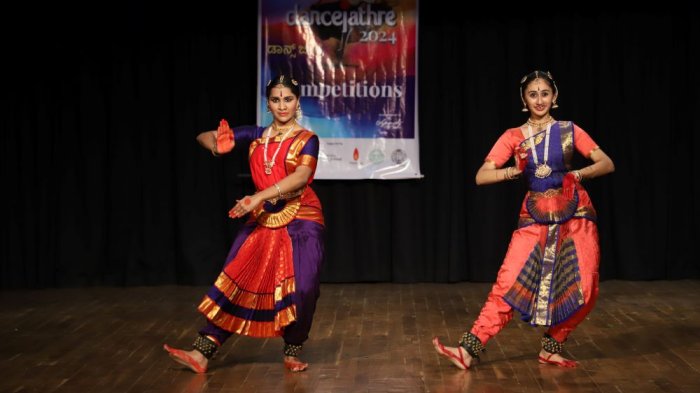 Senior duet 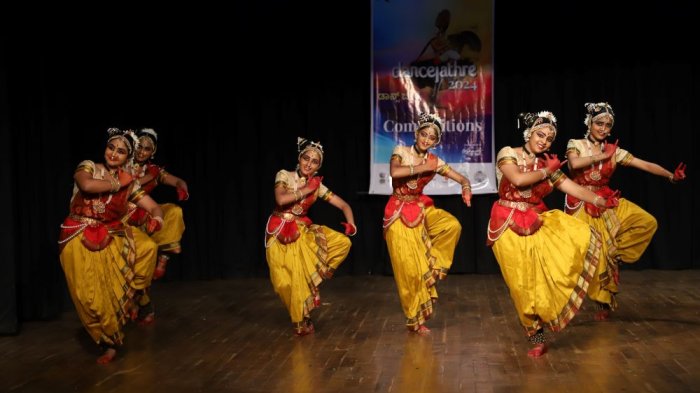 Senior group Dance Jathre has a tradition of also giving special opportunities to the winners of the competitions. Until now, the first two winners of the Senior Group competitions get to perform on the evening stage. The Senior Solo winner gets the "Natya Shive" title and a performance opportunity in the monthly celebration series conducted by Vyjayanthi Kashi. The winner of Solo Junior gets the title "Natya Mandara" and living up to the tradition, the winner of last Dance Jathre, Tanmayi, daughter and disciple of Harshitha Doreswamy got an opportunity to perform at the opening ceremony this year. She lived up to the expectations of all with her exceptional performance at a very young age. This year has seen an overwhelming response from participants for competitions and workshops alike. The different categories in competitions, including Sub-junior, Junior, Senior with Solo, Groups and Duets alike, had competitors coming from Nagpur, Chennai, Bijapur, Hyderabad, Mangalore, and many more cities and towns outside Bangalore too. All-in-all, this year saw a huge number with 300+ participants across competitions and workshops. It was exciting to see some wonderful performances in the competitions. A highlight of the competition was also an enthusiastic group of 60+ year old ladies who performed a folk dance. Kudos to all the judges who did an extremely fair and great job in identifying the best among the best. Dance Jathre 2024 also saw some wonderful, energy packed workshops with an enthusiastic set of participants. 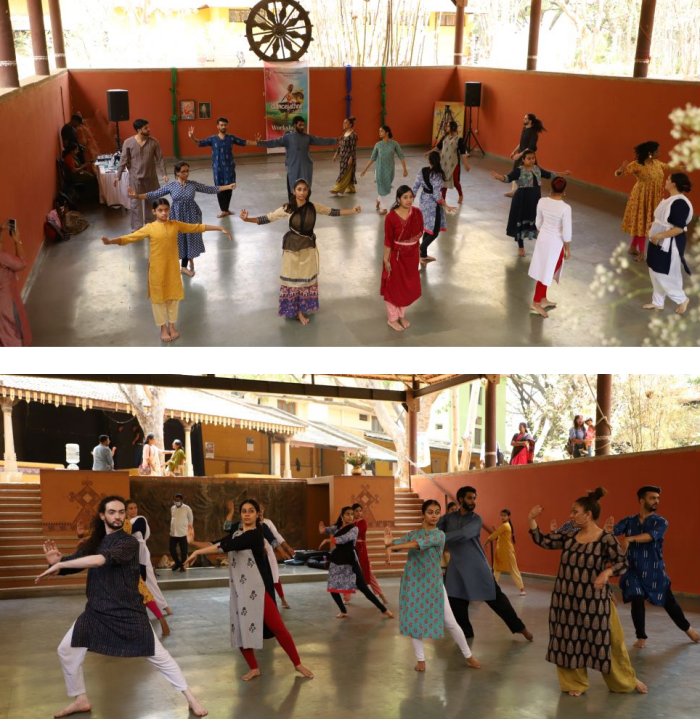 Kathak workshop by Sanjukta Sinha The first day started with a vibrant Kathak workshop. Sanjukta Sinha is an acclaimed Kathak dancer, and senior student of Guru Kumudini Lakhia. She started off her workshop with simple beginners for warm-up. Very soon the workshop took on a very energetic but graceful turn as she started taking the participants through a composition based on Lord Shiva. She emphasized to the participants the importance of using their body movements to build visuals and communicate, that make a performance stand out. The energy of Shiva was brought out with sharp movements of the head, strong and open body movements, and fast footwork. She helped participants understand how small change in hand and body movements can change the dance from tandava to lasya. Vyjayanthi Kashi has ensured that Dance Jathre has always aimed at helping the young participants, to not just understand the rich knowledge behind the forms, but also understand the challenges involved in learning and find ways to improve further. She posed different questions to the accomplished workshop leaders that could bring out these insights. Sanjukta was asked to share her view on how dance brought a change in her life. She spoke of how her attitude to art changed, when she realized that her Guru had given her a lot of knowledge and it only makes more sense if she shares it further prompting her to take up teaching. She highlighted that teaching or being a guru takes away the ego from you. For those who wanted to move between different forms of dance, she advised them to keep persisting, focusing and practising the new form. 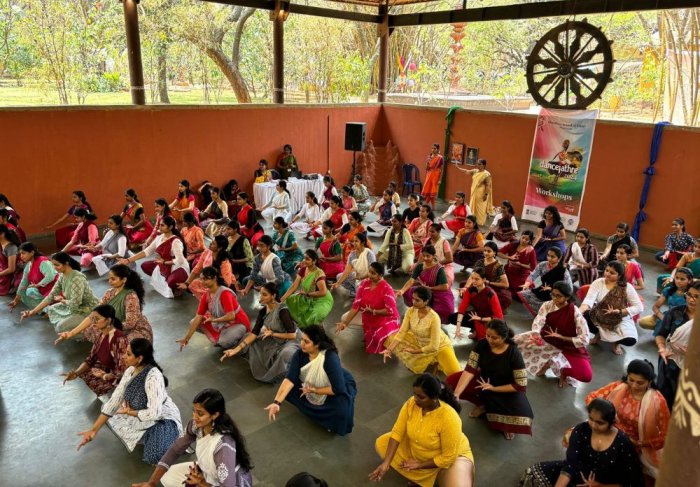 Workshop by Sheela Unnikrishnan The next was the most sought after Bharatanatyam workshop by Sheela Unnikrishnan, the founder of Sridevi Nrithyalaya. In 2 hours, she took the participants through a complete Annamacharya Kriti, which had both abhinaya and nritta. Her disciplined style of teaching was visible right from the moment she started arranging the full house participant crowd to ensure everyone had good visibility. On the other hand, her witty remarks kept the participants smiling, and not overwhelmed. Her unique way of teaching the participants to easily learn the rhythm and the leg movements was very effective, especially considering this was based on khanda chapu taala. One of the quick learnings was on the nuances of how Vishnu is to be portrayed. For eg: Vishnu is never portrayed as being in anger, but he is always shown filled with compassion even while he kills, as his goal is to provide moksha. Sheela Unni, on being posed to share her perspective on what students pursuing dance should focus on, advised the young dancers to decide what is most important to them. In today's world, all youngsters are pressurised by the need of educational excellence as well as following their passion. She suggested that they shouldn't take up dance or any art for the need of earning, but for building excellence and sharing the knowledge across. She also emphasized to the young artistes to focus on practising and performing the same dances multiple times, and not clamour for variety or quantity of dances. More number of times the dance is performed, the quality consistently improves, and more importantly an internal satisfaction on our ability to express the emotions is achieved.  Workshop by Nirupama Rajendra The second day saw a first workshop on Bharatanrityam by Nirupama Rajendra. Bharatanrityam is an amalgamation of the Margi from Natyashastra and the desi style Bharatanatyam, created by Guru Padma Subrahmanyam. The intention of the workshop was to briefly introduce dancers to the vast knowledge available in the Natyashastra. She introduced the participants to bhangis (base posture of body), the different shiro-bhedas (head movements), uraha (chest), paarshva (side), kati (waist), pada (feet), and wrist and hand movements as per the Natyashastra. Moving on to introduce different Bhoomi charis (floor moves) and Akaasha charis (moving with leg in air), she also explained the usage of these charis in different emotions, like playfulness, shyness, and others, which was interesting. Vyjayanthi Kashi requested Nirupama to give her view into what a dancer needs to focus on to excel in this challenging world. Nirupama, emphasized on deciding whether dance is just a hobby or the wish is to be a performer. If hobby, then the emphasis is to just practice a lot and enjoy. But to be a performer, the dancer must completely give in to the Guru's guidance as the Guru is also working hard to nurture the student as a performer. She advised that talent will not work without practice. Application of the knowledge we learn from our teacher or our scriptures, poetry and many other sources is very important. She also emphasized that we as artistes, need to have an intense love for our culture, our scriptures, our stories, and have the added responsibility to share the right content to the world. This was followed by a Kuchipudi workshop by Guru Sudheer Rao from Warangal, who has been the driving force behind Nrithyamala Dance Academy and won multiple awards for promoting Kuchipudi as a teacher and artiste. He picked up a very vibrant and fast traditional Shabdam that was based on the many antics of Krishna. It was interesting to observe also how quickly the participants, amateurs and professionals alike, were able to grasp the complete dance in the short time. His style of teaching in the short time was more based on repetitions of the same lines till it was assimilated. As he rightly said, some of the grace, expressions used in the dance are all possible only within Kuchipudi. He also insisted that students of Kuchipudi should try to learn the Telugu language to be able to appreciate the feelings associated with the lyrics, which will help them emote better. He encouraged the non-Telugu speaking Kuchipudi dancers to follow the footsteps of Vyjayanthi Kashi, explaining the hard work she put in to be one of the best dancers of Kuchipudi. The afternoon on both days ended with energetic workshops by the bubbly Bhumi Thakkar. If first day was dedicated to Gujarat folk, the second day was for Rajasthan. To a participant group that has been more exposed to the Bollywood style of these folk arts, she helped them understand the roots of the dance, and the traditional art. The first day focussed a lot on the traditional style of Garbha which is a meditative dance form and is performed for Mother Earth. The young participants were amazed to realize that many movements in the traditional dance are inspired by movements of daily life like beating grains, grinding and others. She introduced them to both old and new steps like Do taali, Teen taali, Heenj, Daudiya, Dandiya, Tetudo and even the lesser taught Dhakla. On second day, she took them through Ghoomar of Mewar and Kalbelia. Ghoomar is performed only by women and generally, the day after their marriage to express their joy. It was important for participants to understand the background of Ghoomar to be able to appreciate the graceful and subtle movements of wrist and waist involved. She soon navigated the participants towards Kalbelia, which is an art form of the Sapera tribe of Rajasthan. The next day of workshop being Holi, she ended the workshop with an intro to Raas which is a special celebration dance during Holi. Both the evenings ended with some mesmerizing performances by eminent Gurus and their students. The chief guest of the first evening was Guru M. R. Krishna Murthy, Director, Kalakshithi School of Fine Art, popularly known as Kittu Sir. The evening events were inaugurated by Kittu Sir, Vyjayanthi Kashi, Nirupama Rajendra, and Sudheer Rao. Addressing the audience, the chief guest expressed his happiness at being present at Dance Jathre and appreciated Vyjayanthi Kashi's efforts at creating such a platform for all to compete, learn, observe and enjoy. The second day had Dr Nirmala C Eligar, Director, Prasar Bharati as the chief guest.  Sudheer Rao's group The first day, first performance was by the students of Sudheer Rao. The first item was dedicated to goddess Saraswati with the popular song "Mamavatu Shri Saraswati". They followed it up with a performance on Krishna, with "Swagatam Krishna", but adding a twist from regular choreographies by bringing in the Dashavataara. The last performance of the group was on Mahishaasura Mardini. The young girls really stood out convincingly with some very good abhinaya and body language for each character they portrayed.  Abhinava Dance Company This was followed by Bharatanrityam by the students of the acclaimed Abhinava Dance Company, and its artistic director Nirupama Rajendra. The first item was a "Pushpanjali" performed by the students which helped create a divine atmosphere. This was followed by a solo, "Mudakaratha Modakam" performed by Nirupama Rajendra herself. This item was structured into 3 segments, the first explaining Ganesha's attributes, second the divine attributes, and third, a sanchari bhava based on the celebrations of Ganesha. As Nirupama put it, it is important that the audience, including the little children understand the depictions, and she was surely successful based on the answers she got from the little ones. The final item was a celebration of Vasantharutu or the spring, with "Vasantha Thillana" wherein she also incorporated the Sanskrit verses which spoke beautifully of how different flowers blossom by different actions of a woman, like the touch, the laughter, the whispers, and others.  Sanjukta Sinha's group The last performance of the evening was by Sanjukta Sinha, and her students where they presented a composition called "Leela". Her performance and choreography showcased her inimitable style, where she has kept the strong base of Kathak like abhinaya, strong tatkaars or feet movements, and sharp chakkars that flowed across the stage while mixing with graceful body flows of contemporary styles. The audience was enraptured with the aesthetics, costumes and nritta. What could have helped was to give a little introduction to the story and thought process behind the choreography. The second day performances began with a Kathak and a Bharatanatyam group performance by the winners of the Senior Group, performing their winning numbers on stage. 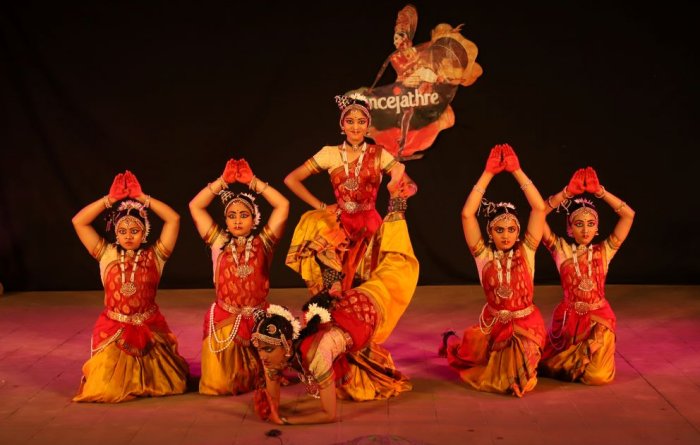 Performance by group winners 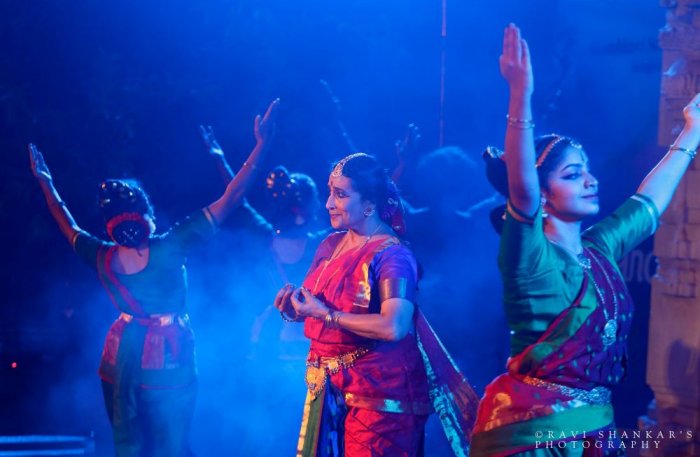 Vyjayanthi Kashi & group This was followed by "Krishnarpanam", a Kuchipudi recital by Vyjayanthi Kashi and her Shambhavi Dance Ensemble. This dance-drama was based on the story of Putana-vadha, where Vyjayanthi Kashi played the pivotal role and stole the audience's heart with her portrayal of Putana in her different avatar, as the demoness as well as a beautiful woman. The interesting part of the performance was to know the little story behind the scenes where Krishna hands over gejje (ghungroo or bells), as a mark of blessing to the dancers. This was inspired by the fact that Siddendra Yogi, the chief architect of Kuchipudi, took a promise from every home in Kuchipudi village, to dedicate a boy to pursue and preserve the art form, and the dedicated dancer would tie a bell round his waist as a mark of this commitment.  Sheela Unnikrishnan's group The final performance of the Jathre was by the students of Sheela Unnikrishnan's Sridevi Nrithyalaya, who performed a thematic presentation "Andal Anubhavam", depicting the story of Andal through her spiritual journey from childhood to her marriage with Lord Venkateshwara. The group captured the audience imagination with their perfect synchronization, beautiful expressions, and the Melattur style of Bharatanatyam. It was interesting to see the little kids portraying the characters as effectively as the elder ones. Vivek effectively hosted the event on both the days, keeping the audience engaged. The 11th edition of Dance Jathre was wrapped up with the award ceremony to all the winners of the 7 categories and thanking all the volunteers and providers of supporting accessories like light, sound, camera, who worked hard for this event. The event's success also rested a lot on the deep involvement and active volunteering of the students and parents of the students of Shambhavi School of Dance. Vyjayanthi Kashi has always insisted on all-round development of her students. She emphasized the need to learn managing, organizing and running of the sub-events like workshop and competitions alike, and being able to interact and handle the audience and their queries that exposes the students to different situations and helps build confidence in them. Some of the same active volunteers were also on stage performing in the evening event. The young volunteers learnt quickly (with initial hiccups) and were able to manage the show completely on the two days. Kudos to the students of Shambhavi School of Dance and Vyjayanthi Kashi for pulling this off successfully again.  Ashwini Naik is a corporate leader, dance enthusiast and an amateur writer. Vice President in a Multinational, Ashwini tries to intertwine her vocation and avocation by driving cultural initiatives in the corporate world. Having trained in Bharatanatyam and Kuchipudi, Ashwini shares her learnings of leadership qualities from dance with her corporate friends. |